
Kryptopterus bicirrhis, often called the glass catfish, is an Asian glass catfish species of the genus Kryptopterus. Until 1989, the concept of K. bicirrhis included its smaller relative Kryptopterus vitreolus. Its scientific name K. bicirrhis and common name glass catfish are often still used in the aquarium fish trade to refer to the actual K. vitreolus; as it seems, the larger and more aggressive true K. bicirrhis was only ever exported in insignificant numbers.

The pearl gourami is a species of gourami native to Southeast Asia.

Wallago is a genus of catfishes order Siluriformes of the family Siluridae, or sheatfish. They are found in rivers throughout southern and southeastern Asia. The only extant species of this genus is Wallago attu.

Wallago attu is a freshwater catfish of the family Siluridae, native to South and Southeast Asia. W. attu is found in large rivers and lakes in two geographically disconnected regions, with one population living over much of the Indian Subcontinent and the other in parts of Southeast Asia. The species can reach a maximum length of 2 m.

Siluridae is the nominate family of catfishes in the order Siluriformes. About 105 living species of silurids are placed in 12 or 14 genera.
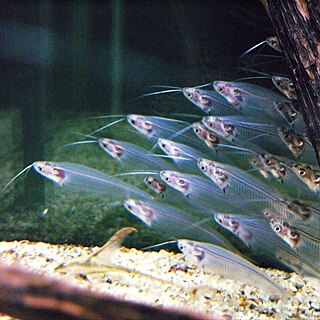
Kryptopterus is a genus of catfishes belonging to the family Siluridae. They are found in freshwater throughout Southeast Asia. The scientific name comes from Ancient Greek kryptós + ptéryx. It refers to the reduced or even entirely absent dorsal fin of these catfishes.
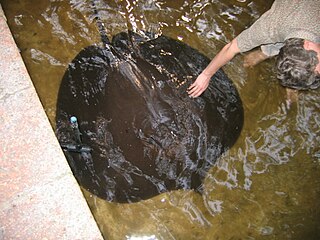
The giant freshwater stingray is a species of stingray in the family Dasyatidae. It is found in large rivers and estuaries in Southeast Asia and Borneo, though historically it may have been more widely distributed in South and Southeast Asia. The largest freshwater fish and the largest stingray in the world, this species grows up to 2.2 m (7.2 ft) across and can reach up to 300 kg (660 lb) in weight. It has a relatively thin, oval pectoral fin disc that is widest anteriorly, and a sharply pointed snout with a protruding tip. Its tail is thin and whip-like, and lacks fin folds. This species is uniformly grayish brown above and white below; the underside of the pectoral and pelvic fins bear distinctive wide, dark bands on their posterior margins.
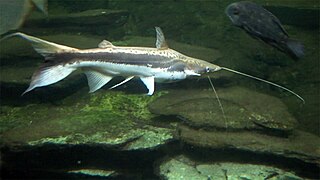
Sorubim is a small genus of long-whiskered catfish native to tropical South America. A number of characteristics allows the differentiation of each species in the genus. Sorubim species are important food fish in South America and are highly significant to fisheries of some areas; however, harvests of these fish are not identified as much as other, more popular food fishes such as Colossoma, Arapaima, and Brachyplatystoma. Some species of this family are popular aquarium fish.
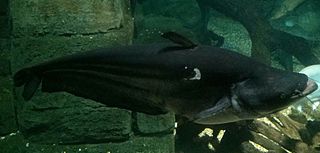
Wallagonia micropogon is a species of catfish in the genus Wallagonia. This species was recently discovered and is found in the Mekong River drainage area between southern Vietnam and northern Laos as well as Chao Phraya River in Thailand. It is a freshwater fish.

Acrochordonichthys is a genus of catfishes of the family Akysidae. It includes ten species.

Hemisilurus is a genus of sheatfishes native to Southeast Asia.

Datnioides microlepis, also known as the Indonesian tiger perch, Indo datmoid, Indonesian tigerfish, or finescale tigerfish, is a species of freshwater ray-finned fish belonging to the family Lobotidae, the tripletails and tiger perches. This species is endemic to the Malay Peninsula and Indonesia.
Wallagonia maculatus is a species of catfish in the family Siluridae endemic to Malaysia, where it is known only from Sabah in northern Borneo. This species grows up to a length of 100 centimetres (39 in) SL.

Phalacronotus apogon is a species of catfish of the genus Phalacronotus found in Southeast Asia. This species grows to a length of 130 centimetres (51 in) SL.

Datnioides undecimradiatus, the Mekong tiger perch is a species of freshwater fish belonging to the family Lobotidae, the triplefins and tiger perches. This species is endemic to the lower and middle Mekong basin in Indochina.

Wallagonia is a recently established genus of Silurid catfishes, containing 3 distinct species, all of whom are native to Southeast Asia:

The giant red tail gourami is a large species of gourami belonging to the family Osphronemidae. This endangered fish is native to the Southeast Asian island of Borneo, where only known from the Kinabatangan and Segama river basins in Sabah, East Malaysia. First described in 1992 based on an aquarium specimen, its exact range was not entirely certain, leading some source to incorrectly also report it from Indonesia.
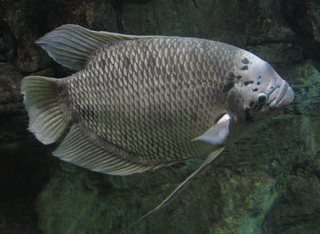
The giant gourami is a species of large gourami native to freshwater habitats in Southeast Asia. It has also been introduced elsewhere. The species is commercially important as a food fish and is also farmed. It can be found in the aquarium trade, as well. The species has been used for weed control on highly invasive aquatic plants like Salvinia molesta, as the giant gourami can be a voracious herbivore.

Kryptopterus macrocephalus, the striped glass catfish, is a species of sheatfish native to the Malay Peninsula, Sumatra and Borneo in Southeast Asia. This species, large for its genus, grows to a length of 9.7 centimetres (3.8 in) SL.

















